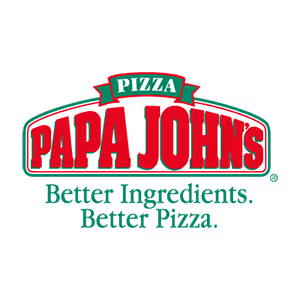Papa John's prepares and delivers pizza, breadsticks, wings, and other food items using quality ingredients. The franchise specializes in hand-tossed pizza with fresh dough and signature sauce available for delivery or carryout.

Key Insights
- Founded on a commitment to quality ingredients and a distinct pizza-making process, Papa John's has grown from a single restaurant to a global brand. The business emphasizes fresh dough, quality toppings, and a signature sauce to create its pizzas, building a recognizable presence in the fast-casual dining sector.
- Papa John's operates through a franchise model, enabling entrepreneurs to own and manage their own restaurants. This model involves providing operational support, marketing strategies, and established supply chains to franchisees, facilitating the expansion of the brand across various markets.
- The franchise operates within the competitive pizza and fast-food industry. This sector is characterized by high consumer demand for convenient and customizable meal options. Papa John's competes by focusing on its unique product offerings and a strong brand identity within this dynamic market.

Franchise Fee and Costs to Open
Exploring the financial picture of Papa John's gives insight into both the upfront commitment and the potential revenue opportunity. According to FDD Item 7, opening this franchise typically involves an investment in the range of $261,165 - $853,365, along with a franchise fee of $5,000 - $25,000.
Financial Performance and Revenue
Yearly gross sales of $1,068,262 and estimated earnings of $128,192 - $160,240 show the potential financial performance of this franchise. These figures are crucial for prospective franchisees as they help to project revenue and profitability. They offer insight into the business's ability to generate income and can be used to compare its performance against other investment opportunities. The Franchise Payback Period of 4.4-6.4 provides an estimation of the time it might take for an owner to recover their initial investment. This metric is a key consideration for anyone evaluating the financial viability of a franchise, as it relates directly to the speed at which the business can become profitable. A shorter payback period can indicate a faster return on capital, which is a significant factor in making an informed decision about a franchise investment.
Training and Resources
Papa John's provides comprehensive training for new franchisees. This initial program offers extensive instruction on operations and brand standards. The training length is approximately four weeks and is conducted at a designated Papa John's corporate training facility. Papa John's also offers ongoing support and resources to assist franchisees in building their business.
Legal Considerations
Legal considerations for a Papa John's franchisee are outlined in the Franchise Disclosure Document (FDD) and the Franchise Agreement. Note that this franchise discloses lawsuits and/or bankruptcy information in its FDD, which may impact your evaluation. Subscribe now to access more details and be sure to consult a qualified attorney before proceeding.
Challenges and Risks
Running a Papa John's franchise involves considerations such as navigating a competitive local market with established players. Operational complexity arises from managing staffing, ensuring consistent product quality across all offerings, and maintaining efficient delivery logistics. Furthermore, reliance on specific supply chains for ingredients and materials presents a potential consideration for maintaining inventory and controlling costs.



